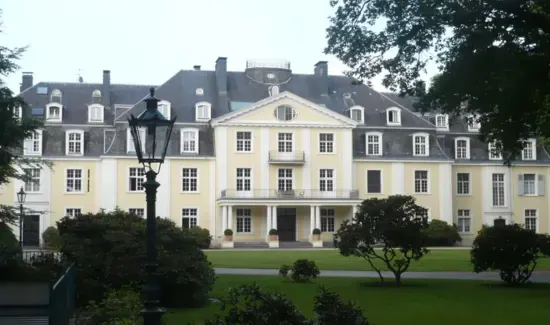The city's name comes from a huge woodland called "Meerer Busch", owned by the monastery Prämonstratenserinnenkloster Meer. The rest of the monastery can be visited in the "Meerhof" or so called "Haus Meer". You also should take a look at the 13th century church tower which is located in Meerbusch-Büderich. Today it is used as a memorial for war victims.
The first recorded evidence of settlements in Meerbusch represent remnants of the great Roman villa in Ilverich near the limit of 70 AD, another Roman villa on the border Lank-Latum/Nierst and a Roman villa found in Osterath dar. In the course of industrialization, Osterath had the first steam engine in the area in 1883, paving the way for a population explosion. Industrial parks started to pop up and it only attracted more people to the area.
![By Tetris L (Own work) [GFDL (http://www.gnu.org/copyleft/fdl.html) or CC-BY-SA-3.0-2.5-2.0-1.0 (http://creativecommons.org/licenses/by-sa/3.0)], via Wikimedia Commons](/images/allgemein/meerbusch.jpg) By Tetris L (Own work) [GFDL (http://www.gnu.org/copyleft/fdl.html) or CC-BY-SA-3.0-2.5-2.0-1.0 (http://creativecommons.org/licenses/by-sa/3.0)], via Wikimedia Commons
By Tetris L (Own work) [GFDL (http://www.gnu.org/copyleft/fdl.html) or CC-BY-SA-3.0-2.5-2.0-1.0 (http://creativecommons.org/licenses/by-sa/3.0)], via Wikimedia Commons
Meerbusch today
Meerbusch is a town in the Rhein- Kreiss Neuss area in North Rhine- Westphalia. It has a very high proportion of millionaries in the area. It is very rural in character, approximatley 3600 hectares of agricultural land 540 hectares of forest and 300 hectares of water. The city covers 12km from north to south and 8km east to west. The city stretches over 12.5km
![By Tetris L (Own work) [GFDL (http://www.gnu.org/copyleft/fdl.html) or CC-BY-SA-3.0-2.5-2.0-1.0 (http://creativecommons.org/licenses/by-sa/3.0)], via Wikimedia Commons](/images/allgemein/meerbusch.jpg)









